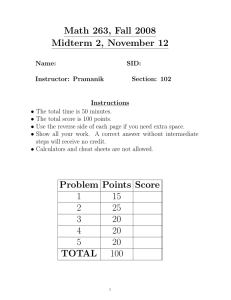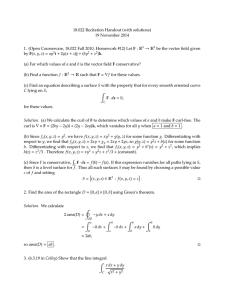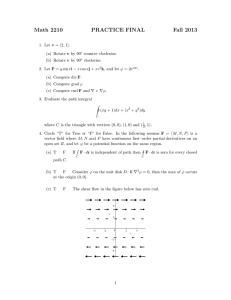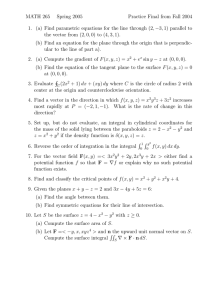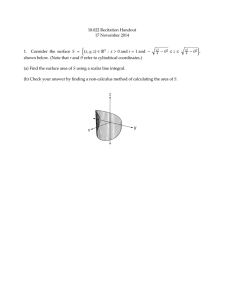Math 2210 PRACTICE FINAL SOLUTIONS Fall 2013
advertisement
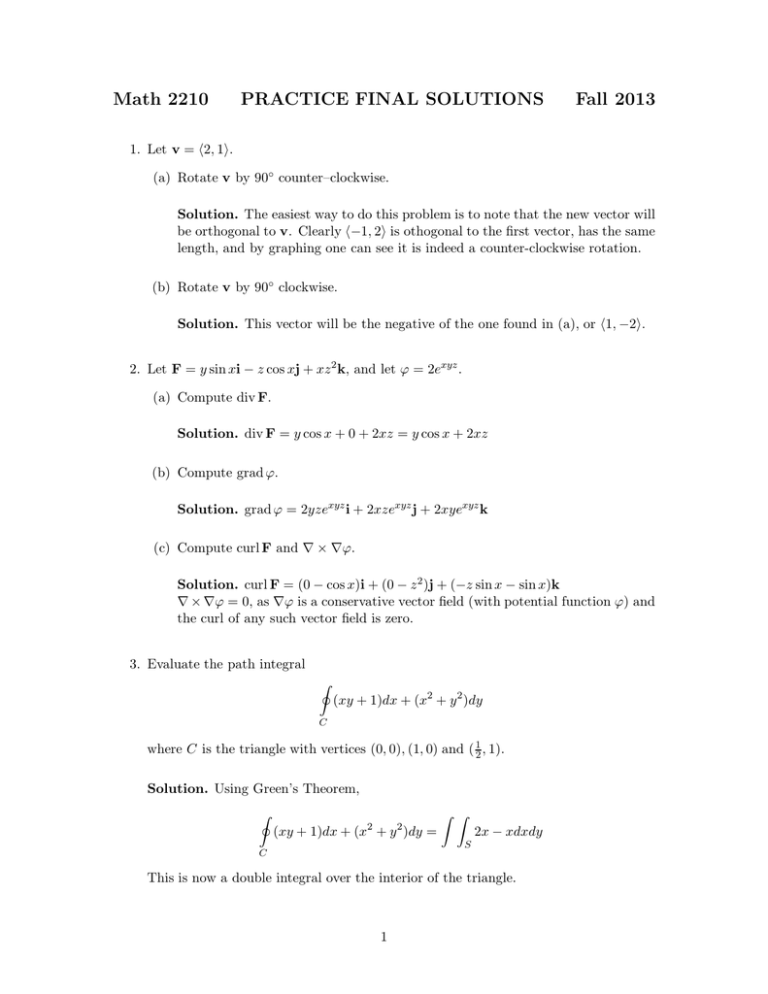
Math 2210
PRACTICE FINAL SOLUTIONS
Fall 2013
1. Let v = h2, 1i.
(a) Rotate v by 90◦ counter–clockwise.
Solution. The easiest way to do this problem is to note that the new vector will
be orthogonal to v. Clearly h−1, 2i is othogonal to the first vector, has the same
length, and by graphing one can see it is indeed a counter-clockwise rotation.
(b) Rotate v by 90◦ clockwise.
Solution. This vector will be the negative of the one found in (a), or h1, −2i.
2. Let F = y sin xi − z cos xj + xz 2 k, and let ϕ = 2exyz .
(a) Compute div F.
Solution. div F = y cos x + 0 + 2xz = y cos x + 2xz
(b) Compute grad ϕ.
Solution. grad ϕ = 2yzexyz i + 2xzexyz j + 2xyexyz k
(c) Compute curl F and ∇ × ∇ϕ.
Solution. curl F = (0 − cos x)i + (0 − z 2 )j + (−z sin x − sin x)k
∇ × ∇ϕ = 0, as ∇ϕ is a conservative vector field (with potential function ϕ) and
the curl of any such vector field is zero.
3. Evaluate the path integral
I
(xy + 1)dx + (x2 + y 2 )dy
C
where C is the triangle with vertices (0, 0), (1, 0) and ( 12 , 1).
Solution. Using Green’s Theorem,
I
2
2
(xy + 1)dx + (x + y )dy =
Z Z
S
C
2x − xdxdy
This is now a double integral over the interior of the triangle.
1
=
Z
0
1 Z 1−y/2
y/2
xdxdy =
Z
0
1
2
2
((1 − y/2) /2 − (y/2) /2)dy =
Z
1
0
4 − 4y
8
= (y/2 − y 2 /4)|10 = 1/4.
4. Circle “T” for True or “F” for False. In the following assume F = hM, N, P i is a
vector field where M, N and P have continuous first–order partial derivatives on an
open set R, and let ϕ be a potential function on the same region.
R
H
(a) T
F
If F · dr is independent of path then F · dr is zero for every closed
path C.
C
C
Solution. True, since if the path does not matter then any closed path has the
same integral as the path that stays at a single point, which has value 0.
(b) T
F
Consider ϕ on the unit disk D. If ∇2 ϕ = 0, then the max of ϕ occurs
at the origin (0, 0).
Solution. False. The maximum cannot occur at the origin because the above
describes a harmonic function, whose maximum must occur on the boundary
(the circle).
(c) T
F
The shear flow in the figure below has zero curl.
Solution. False. Recall that if a vector field has zero curl then line integrals are
path dependent. But, for example, taking a starting point of (-1, 0) and ending
point of (1, 0), the upper half circle works with the vector field and the lower
half circle works against it, so they must have different integrals.
5. Use Green’s Theorem to compute the area of any region S in the plane. That is show
I
A(S) = F · T ds.
∂S
where F = − 12 yi + 12 xj. (Hint: See your textbook)
Solution. What follows is a paraphrase from the top of Pg. 751 and Pg. 753 in the
text.
The tangent vector T at a point (x, y) on the curve parameterized by s can be written
T=
dy
dx
ds i + ds j.
So, the integral may be rewritten
2
I
F · T ds =
∂S
I
(− 12 yi + 12 xj) · (
dy
dx
i + j)ds
ds
ds
∂S
=
I
− 12 ydx + 21 xdy
∂S
Now by Green’s Theorem and the definition of area of a region,
=
Z Z
(1/2 + 1/2)dA =
S
Z Z
1dA = A(S)
S
6. Consider the force field F(x, y) = h2xy, x2i. Find
Z
W = F · dr ,
Γ
the work done in moving an object in this field from the origin (0, 0) to (1, 1) along
the parabolic arc Γ described by the graph of y = x2 connecting these two points.
(Hint: Determine whether this force is conservative, and use a potential function to
find the integral if it is. Otherwise, parameterize the arc and compute it directly.)
Solution. curl F = 2x − 2x = 0, thus the vector field is conservative. An antiderivative G is G(x, y) = x2 y. Thus we calculate the work done by computing
G(1, 1) − G(0, 0) = 1 − 0 = 1.
7. Let Ω ⊂ R2 be the disk of radius 2, Ω = {(x, y) ∈ R2 : x2 + y 2 ≤ 4}. Consider the
fluid velocity field v(x, y) = h−y 3 , x3 i on Ω.
(a) Find the curl of the fluid velocity, ∇ × v.
Solution. curl v = (3x2 + 3y 2 )k.
(b) Use Green’s Theorem to evaluate the circulation of v around the boundary of Ω.
That is, find the line integral
I
v · dr.
∂Ω
around the circle of radius 2 forming the boundary ∂Ω of the disk Ω, traversed in
the counterclockwise direction, by using your result from (a) in the area integral
from Green’s Theorem.
Solution. By Green’s Theorem,
I
Z Z
v · dr =
3x2 + 3y 2 dxdy
Ω
∂Ω
3
Changing to polar coordinates,
=
Z
2π
0
Z
2
3r 2 rdrdθ = 24π.
0
8. Suppose that an object of mass m is moving along a smooth curve C given by
r = r(t) = x(t)i + y(t)j + z(t)k,
a ≤ t ≤ b.
under the influence of a conservative force F(r) = ∇f (r). From physics, we learn
three facts about the object at time t
(a) F(r(t)) = mr00(t)
(b) KE =
(Newton’s Second Law)
1
0
2
2 m||r (t)||
(kinetic energy)
(c) P E = −f (r)
(potential energy)
Use the above to prove
d
(KE + P E) = 0.
dt
That is that energy is conserved over time. (Hint: See page 747 of your text.)
Solution. What follows is a paraphrase of what appears on Pg. 747. Calculating
explicitly,
d
d
(KE + P E) = ( 12 m||r0(t)||2 − f (r))
dt
dt
= mr00 (t) · r0 (t) − ∇f (r) · r0 (t)
= (mr00 (t) − ∇f (r)) · r0 (t)
= (F(r) − F(r)) · r0 (t) = 0
On the last line, the first F(r) came from Fact 1 and the second F(r) came from
the definition of F as a conservative force field. The fact that energy is conserved is
apparent in that the derivative with respect to time t of the total energy (kinetic plus
potential) is 0 everywhere.
9. Use the Divergence Theorem to evaluate the flux integral
ZZ
F · n dS
∂Ω
4
where F = (x − 2xy)i + y 2 j + 3zk and Ω is the solid sphere of radius 3 centered at the
origin.
Solution.
ZZ
F · n dS =
Z Z Z
div FdV =
Ω
Z Z Z
Ω
((1 − 2y) + (2y) + 3)dV =
Z Z Z
4dV
Ω
∂Ω
This last expression is 4 times the volume of the sphere of radius 3, or 4( 43 π33 ) = 144π.
10. Compute the flux through the unit sphere for the vector field F(r) = r.
Solution. Write F(x, y, z) = xi + yj + zk, and compute div F = 1 + 1 + 1 = 3. Now,
the flux integral simplifies like the previous problem to an integral over the volume of
the sphere:
ZZ
F · n dS =
Z Z Z
div FdV =
Ω
Z Z Z
3dV
Ω
∂Ω
Now the last expression is 3 times the volume of the sphere, or 3( 43 π13 ) = 4π.
11. Solve Laplace’s equation explicitly in one dimension,
uxx =
d2 u
= 0.
dx2
Consider a harmonic function u(x) solving the above equation on the interval [a, b].
Demonstrate by graphing u(x) that it attains its maximum and minimum values on
the boundary of [a, b].
Solution. The solution in one dimension is found simply by integrating:
ux = C
u(x) = Cx + D
Where C, D are constants. Since this is just linear, with constant slope, there are
no local maxima/minima and the global maximum/minimum will occur at opposite
boundary points.
12. Evaluate the surface integral
ZZ
(x2 + y 2 ) dS
G
5
where G is the part of the paraboloid z = 1 − x2 − y 2 that projects onto the region
R = {(x, y) : x2 + y 2 ≤ 1}.
Solution. This comes from Pg. 757 in the book.
ZZ
Z Z
(x2 + y 2 ) dS =
R
G
=
Z
2π
Z
0
Setting u =
√
p
(x2 + y 2 ) (−2x)2 + (−2y)2 + 1dA
1
r2
0
p
4r 2 + 1 rdrdθ
4r 2 + 1 so that u2 = 4r 2 + 1 and 2udu = 8rdr,
=
Z
0
2π Z
√
5
1/4(u2 − 1)u(1/4udu)dθ
1
= 1/16
Z
0
2π Z
√
5
1
(u2 − 1)u2 dudθ
√
√
50 5 + 2
(25 5 + 1)π
= 1/16(2π)(
)=
15
60
13. Let S be the solid determined by 1 ≤ x2 + y 2 + z 2 ≤ 4, and let F = xi + (2y + z)j +
(z + x2 )k. Evaluate
ZZ
F · n dS
∂S
Solution. Use the Divergence Theorem to rewrite the integral as
Z Z Z
div FdV =
S
Z Z Z
(1 + 2 + 1)dV
S
This is 4 times the volume integral over the region between two spheres of radius 1
and 2 centered at the origin, so the answer is
4(4/3π(23) − 4/3π(13)) = 112π/3.
14. Consider the potential energy of a harmonic oscillator in three dimensions given by
ϕ(x, y, z) =
k 2
x + y2 + z2 .
2
6
(a) Find the force F(x, y, z) = −∇ϕ at a given position r = (x, y, z).
Solution. −∇ϕ = −k/2(2xi + 2yj + 2zk) = −kxi − kyj − kzk.
(b) What are the equipotential surfaces (level sets)?
Solution. Setting the potential function ϕ = C for some constant C, the resulting equation is that of a sphere centered at the origin.
(c) Find the divergence and curl of F, that is, find ∇ · F and ∇ × F.
Solution.
div F = −k − k − k = −3k.
curl F = 0 since F is conservative (it is the gradient of ϕ).
(d) Use the divergence theorem for F over Ω = {(x, y, z) ∈ R3 : x2 + y 2 + z 2 ≤ a2 },
the ball of radius a, and your result from (b), to find the flux
ZZ
F · n dS
∂Ω
of F through the spherical surface ∂Ω = {(x, y, z) ∈ R3 : x2 + y 2 + z 2 = a2 }.
Solution. This part is practically identical to Problem 10.
ZZ
F · n dS =
Z Z Z
Ω
div FdV =
Z Z Z
Ω
−3kdV
∂Ω
This last expression is −3k times the volume of the sphere of radius a, or −4kπa3 .
7
